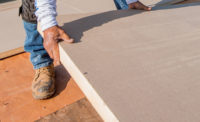Choosing Environmentally Preferable Insulation
Significant Issues and Decision Making Tools

More and more professionals are recognizing the benefits of green building for a variety of reasons ranging from health and comfort to image, branding and tax breaks. Buildings can be considered green only if they are well insulated. The insulation materials you choose now will be in your buildings for many years, with long lasting impacts on the energy use of the structure and on the health and comfort of the occupants. It is already a challenge to identify green insulation products that are functional and cost-effective; the limited information that is available about the sustainability of the insulation materials currently offered on the market makes this task even more complex.
Green Seal has conducted an extensive evaluation of thermal insulation materials while developing a new environmental leadership standard for architectural insulation, with input from dozens of diverse stakeholders representing many sectors of the market. We identified the most important issues that will help you choose the leadership products that are better for human and environmental health. A number of tools are available to help you make these decisions but they do not provide all the information you need.
Partial Guidance from Building Codes and Green Building Ratings. The current building codes and popular green-building rating programs focus on the insulation of the overall structure rather than setting requirements for insulation materials. They require minimum R-values for different parts of a structure, recognizing that properly insulated buildings deliver significant environmental benefits. These include lower emissions of greenhouse gases, cleaner air, better health, reduced use of resources and fossil fuels, reduced burden on power grids, reduced energy bills, and significant improvements in indoor comfort. In order to reap these benefits, these high-performing products require advanced chemistry and an initial investment of energy and resources. Even though some of these materials may pose potential hazards, all types of insulation, if installed correctly, are considered inert and non-toxic.
Review of Green Insulation Materials. The rating programs and building codes provide very little guidance on choosing environmentally preferable insulation products. Here are the significant things you need to know in order to make an informed choice.
Function of the Insulation
Products That Work. The first requirement for a sustainable product is that it has to get the job done. One approach is to have the product comply with industry-accepted specifications, such as ASTM1, which specifies how to measure R-value, as well as listing the important functions provided by each type (e.g., compressive strength, water resistance, vapor transmission, etc.) and complicating factors (e.g., the potential deterioration of R-value over time).
Issues During Manufacturing
Climate Change. Insulation materials should save more energy and greenhouse gas emissions over their lifetime than was invested in their production. In general, for all of the insulation categories included in our analysis, the greenhouse gases saved over their lifetime are significantly greater than those invested in their creation. Greenhouse gases are emitted in two ways during manufacture:
- Use of Energy in Manufacture. Some categories of insulation materials are energy-intensive, including those made from glass or slag, which require high temperatures to melt the raw materials and turn them into fibers, and petroleum-based products such as polystyrene and polyurethane. The energy used in the production of insulation materials contributes to climate change. Cellulose and cotton are two major insulation categories that use less energy during manufacture; their use in roofing applications may, however, be limited.
- Use of Blowing Agents in Manufacture. Foam insulation, including polystyrene, polyurethane and polyisocyanurate, requires blowing agents to give them volume. Historically, blowing agents were very potent greenhouse gases. The industry has transitioned away from the worst offenders and is in the process of transitioning to the least harmful options. Leadership products use blowing agents that contribute significantly less to climate change.
Recycled Content. Using recycled materials in the manufacturing process reduces the use of non-renewable resources, diverts waste from landfills and generally requires less energy during processing. The EPA’s Comprehensive Procurement Guidelines2 recommend minimum recycled content for a number of product categories; cellulose and cotton materials should contain at least 80 percent postconsumer recycled material.
Issues During Installation
Installation Procedures and Protective Equipment. When installed according to manufacturers’ instructions, insulation will function as intended, prevent premature failure, and help protect the health and safety of installers and occupants. Even better is to have it installed by trained professionals. If you’re interested in credible installation procedures, ASTM has developed industry-accepted standard practice for the installation of loose fill, mineral fiber batts and reflective insulation; sector-specific industry groups have published installation practices for the product categories they represent, such as spray polyurethane foams.
Safe work procedures and correct protective equipment should be used for all types of insulation materials, for the health and safety of the installation workers and the occupants of the building. Some of the hazards involved include the release of particles into the air from loose-fill, skin irritation from fiberglass and respiratory exposure to the raw materials of spray polyurethane foam.
Recommended protective equipment ranges from safety glasses and long sleeves, face masks and gloves, to supplied-air respirators and full-body suits, as appropriate for the type of material being installed. Additional protective measures may include work areas restricted to protected workers or waiting times of at least 24 hours before access is granted to unprotected occupants.
Issues During Building Occupancy
Indoor Air Quality. Once insulation is installed behind a wall or other barrier, it can affect occupants mainly via the release of Volatile Organic Compounds (VOCs). VOCs are associated with various health problems and negative environmental impacts; they are restricted by regulations and green building programs. Because there are no federal regulations for construction materials, the limits set by the State of California have been adopted by the market as national leadership levels for VOC emissions from insulation products.3
How to Choose
Architects who want to make sustainable choices need to identify products that are not only cost-effective in meeting functional specifications, but also provide greater benefits for environmental and personal health compared to the available alternatives. Leadership products are those that provide benefits in all of the areas discussed above. Identifying them can be a challenging task even for those professionals who have the resources, training and access to all the necessary information. A number of tools are currently available to support decision making, but most of them fall short.
Green Building Programs. As mentioned above, the various rating programs for green buildings (e.g., USGBC LEED and Green Globes) do not set comprehensive criteria for insulation materials or identify products that are environmentally preferable. Additionally, their criteria do not cover all of the major impact areas that we have just discussed.
Single Attribute Certifications. A number of third-party certifications are available for single attributes, which are only one part of the complex picture of environmental leadership. Only looking at one specific attribute also does not guarantee that the product will perform as expected or provide benchmarks that reflect market leadership using a single attribute certification to verify, say, recycled content or VOC emissions may miss out on other important issues such as climate change or the presence of hazardous chemicals.
Environmental/Health Product Declarations (EPD/HPD). Many manufacturers of insulation materials have published EPDs or HPDs. However, EPDs are not a particularly useful tool for architects who wish to select environmentally preferable insulation products. Even if you get past the many pages of highly technical data, the EPD does not put that information in context to help you recognize leadership products in the market. The architect is then left with a lot of work to compare a number of EPDs and attempt to identify which products are preferable.
Multi-Attribute Ecolabels. The drawbacks of each of the previous options are resolved with a third-party certification that evaluates performance and multiple environmental attributes across key life-cycle stages of the product, also known as a Type I ecolabel. Only with this approach are you guaranteed that all of the important issues have been included in the analysis, and such certified products truly represent leadership in today’s market.
Compared with other choices on the market, environmentally preferable insulation materials deliver clear benefits, including climate change reduction, strict limited hazardous chemicals and VOC emissions, recycled content, responsible packaging, installation instructions, and effective insulation that will provide energy savings, improved air quality and greater comfort for building occupants.
Visit GreenSeal.org to learn more about Green Seal standards, certified products and services.
References
1. www.astm.org/Standards/thermal-insulation-standards.html
2. www.epa.gov/smm/comprehensive-procurement-guidelines-construction-products
Looking for a reprint of this article?
From high-res PDFs to custom plaques, order your copy today!





